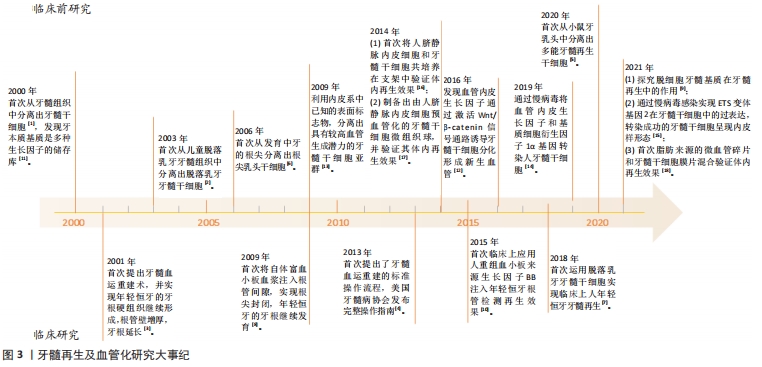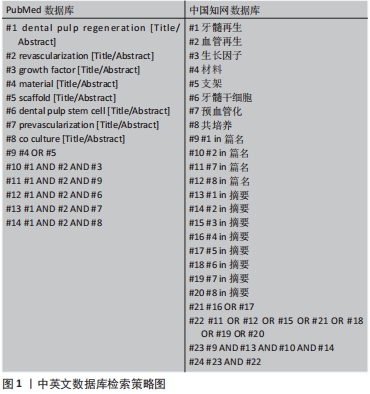[1] JUNG C, KIM S, SUN T, et al. Pulp-dentin regeneration: current approachs and challenges. J Tissue Eng. 2019;10:1-13.
[2] ZHANG W, YELICK PC. Vital pulp therapy-current progress of dental pulp regeneration and revascularization. Int J Dent. 2010;2010:1-9.
[3] CARMELIET P, JAIN RK. Angiogenesis in cancer and other diseases. Nature. 2000;407(6801):249-257.
[4] POTENTE M, GERHARDT H, CARMELIET P. Basic and therapeutic aspects of angiogenesis. Cell. 2011;146(6):873-887.
[5] UTZINGER U, BAGGETT B, WEISS JA, et al. Large-scale time series microscopy of neovessel growth during angiogenesis. Angiogenesis. 2015;18(3):219-232.
[6] 贺露,郭俊,杨健.再血管化和牙组织工程化牙髓再生的研究进展[J].国际口腔医学杂志,2015,42(4):485-491.
[7] 钟小奕,陈文霞.血管再生研究进展及其应用[J].国际口腔医学杂志,2009,36(2):183-185.
[8] 韩琦,王效英.牙髓血管再生的相关研究进展[J].口腔医学,2019, 39(4):371-375.
[9] SAGBIRI MA, ASATOURIAN A, SORESON CM, et al. Role of angiogenesis in endodontics: contributions of stem cells and proangiogenic and antiangiogenic factors to dental pulp regeneration. J Endod. 2015; 41(6):797-803.
[10] FERRARA N, GERBER HP, LECOUTER J. The biology of VEGF and its receptors. Nat Med. 2003;9(6):669-676.
[11] FERRARA N, DAVIS-SMYTH T. The biology of vascular endothelial growth factor. Endocr Rev. 1997;18(1):4-25.
[12] ROBERTS WG, PALADE GE. Increased microvascular permeability and endothelial fenestration induced by vascular endothelial growth factor. 1995;108(6):2369-2379.
[13] TRAN-HUNG L, MATHIEU S, ABOUT I. Role of human pulp fibroblasts in angiogenesis. J Dent Res. 2006;85(9):819-823.
[14] ARANHA AMF, ZHAOCHENG Z, NEIVA KG, et al. Hypoxia enhances the angiogenic potential of human dental pulp cells. J Endod. 2010;36(10): 1633-1637.
[15] ROBERTS-CLARK DJ, SMITH AJ. Angiogenic growth factors in human dentine matrix. Arch Oral Biol. 2000;45(11):1013-1016.
[16] ZHANG Z, NÖR F, OH M, et al. Wnt/β‐catenin signaling determines the vasculogenic fate of postnatal mesenchymal stem cells. Stem Cells. 2016;34:1576-1587.
[17] MULLANE EM, DONG Z, SEDGLEY CM, et al. Effects of VEGF and FGF2 on the revascularization of severed human dental pulps. J Dent Res. 2008;87(12):1144-1148.
[18] TALLQUIST M, KAZLAUSKAS A. PDGF signaling in cells and mice. Cytokine Growth Factor Rev. 2004;15(4):205-213.
[19] KECK PJ, HAUSER SD, KRIVI G, et al. Vascular permeability factor, an endothelial cell mitogen related to PDGF. Science. 1989;246(1): 1309-1312.
[20] STAVRIA GT, HONG Y, ZACHARY CI, et al. Hypoxia and platelet-derived growth factor-BB synergistically upregulate the expression of vascular endothelial growth factor in vascular smooth muscle cells. FEBS Lett. 1995;358(3):311-315.
[21] MATSUOKA J, GROTENDORST GR. Two peptides related to platelet-derived growth factor are present in human wound fluid. Proc Natl Acad Sci U S A. 1989;86(12):4416-4420.
[22] ZHUJIANG A, KIM SG. Regenerative endodontic treatment of an immature necrotic molar with arrested root development by using recombinant human platelet-derived growth factor: a case report. J Endod. 2016;42(1):72-75.
[23] BEENKEN A, MOHAMMADI M. The FGF family: biology, pathophysiology and therapy. Nat Rev Drug Discov. 2009;8(3):235-253.
[24] BERGERS G, HANAHAN D. Modes of resistance to anti- angiogenic therapy. Nat Rev. 2008;8(8):592-603.
[25] BRONCKAERS A, HILKENS P, YANICK F, et al. Angiogenic properties of human dental pulp stem cells. PLoS One. 2013;8(8):e71104.
[26] TAKEUCHI N, HAYASHI Y, MURAKAMI M, et al. Similar in vitro effects and pulp regeneration in ectopic tooth transplantation by basic fibroblast growth factor and granulocyte‐colony stimulating factor. Oral Dis. 2015; 21(1):113-122.
[27] GORIN C, ROCHEFORT GY, BASCETIN R, et al. Priming dental pulp stem cells with fibroblast growth factor-2 increases angiogenesis of implanted tissue-engineered constructs through hepatocyte growth factor and vascular endothelial growth factor secretion. Stem Cells Transl Med. 2016;5(3):392-404.
[28] LIEKENS S, SCHOLS D, HATSE S. CXCL12-CXCR4 axis in angiogenesis, metastasis and stem cell mobilization. Curr Pharm Des. 2010;16(35): 3903-3920.
[29] YANG JW, ZHANG YF, WAN CY, et al. Autophagy in SDF-1α-mediated DPSC migration and pulp regeneration. Biomaterials. 2015;44: 11-23.
[30] MIN KS, Lee Y, HONG SO, et al. Simvastatin promotes odontoblastic differentiation and expression of angiogenic factors via heme oxygenase-1 in primary cultured human dental pulp cells. J Endod. 2010;36(3):447-452.
[31] KIM MK, PARK HJ, KIM YD, et al. Hinokitiol increases the angiogenic potential of dental pulp cells through ERK and p38MAPK activation and hypoxia-inducible factor-1α (HIF-1α) upregulation. Arch Oral Biol. 2014;59(2):102-110.
[32] XIAN X, GONG Q, LI C, et al. Exosomes with highly angiogenic potential for possible use in pulp regeneration. J Endod. 2018;44(5):751-758.
[33] WU S, ZHOU Y, YU Y, et al. Evaluation of chitosan hydrogel for sustained delivery of VEGF for odontogenic differentiation of dental pulp stem cells. Stem Cells Int. 2019;2019:1-14.
[34] LI X, MA C, XIE X, et al. Pulp regeneration in a full-length human tooth root using a hierarchical nanofibrous microsphere system. Acta Biomater. 2016;35:57-67.
[35] Zhang R, Xie L, Wu H, et al. Alginate/laponite hydrogel microspheres co-encapsulating dental pulp stem cells and VEGF for endodontic regeneration. Acta Biomater. 2020;113:305-316.
[36] SILVA CR, BABO PS, GULINO M, et al. Injectable and tunable hyaluronic acid hydrogels releasing chemotactic and angiogenic growth factors for endodontic regeneration. Acta Biomater. 2018;77:155-171.
[37] ZHANG S, THIEBES AL, KREIMENDAHL F, et al. Extracellular vesicles-loaded fibrin gel supports rapid neovascularization for dental pulp regeneration. Int J Mol Sci. 2020;21(12):4226.
[38] SONG JS, TAKIMOTO K, JEON M, et al. Decellularized human dental pulp as a scaffold for regenerative endodontics. J Dent Res. 2017;96(6): 640-646.
[39] ALGHUTAIMEL H, YANG X, DRUMMOND B, et al. Investigating the vascularization capacity of a decellularized dental pulp matrix seeded with human dental pulp stem cells: in vitro and preliminary in vivo evaluations. Int Endod J. 2021. doi:10.1111/iej.13510.
[40] CERVANTES J, PERPER M, WONG LL, et al. Effectiveness of platelet-rich plasma for androgenetic alopecia: a review of the literature. Skin Appendage Disord. 2018;4(1):111.
[41] DING RY, CHEUNG GS, CHEN J, et al. Pulp revascularization of immature teeth with apical periodontitis: a clinical study. J Endod. 2009;35(5):745-749.
[42] ZHU X, WANG Y, LIU Y, et al. Immunohistochemical and histochemical analysis of newly formed tissues in root canal space transplanted with dental pulp stem cells plus platelet-rich plasma. J Endod. 2014;40(10): 1573-1578.
[43] DOHAN EHRENFEST DM, RASMUSSON L, ALBREKTSSON, T. Classification of platelet concentrates: from pure platelet-rich plasma (P-PRP) to leucocyte-and platelet-rich fibrin (L-PRF). Trends Biotechnol. 2009;27(3):158-167.
[44] CHEN YJ, ZHAO YH, ZHAO YJ, et al. Potential dental pulp revascularization and odonto-/osteogenic capacity of a novel transplant combined with dental pulp stem cells and platelet-rich fibrin. Cell Tissue Res. 2015;361(2):439-455.
[45] SLOAN AJ, WADDINGTON RJ. Dental pulp stem cells: what, where, how? Int J Paediatr Dent. 2009;19(1):61-70.
[46] SONGTAO S, GRONTHOS S. Perivascular niche of postnatal mesenchymal stem cells in human bone marrow and dental pulp. J Bone Miner Res. 2003;18(4):696-704.
[47] GANDIA C, ARMIÑAN A, GARCÍA-VERDUGO JM, et al. Human dental pulp stem cells improve left ventricular function, induce angiogenesis, and reduce infarct size in rats with acute myocardial infarction. Stem Cells. 2008;26(3):638-645.
[48] IOHARA K, IMABAYASHI K, ISHIZAKA R, et al. Complete pulp regeneration after pulpectomy by transplantation of cd105 + stem cells with stromal cell-derived factor-1. Tissue Eng Part A. 2011; 17(15-16):1911-1920.
[49] IOHARA K, ZHENG L, WAKE H, et al. A novel stem cell source for vasculogenesis in ischemia: subfraction of side population cells from dental pulp. Stem Cells. 2008;26:2408-2418.
[50] ZHU L, DISSANAYAKA WL, ZHANG C. Dental pulp stem cells overexpressing stromal-derived factor-1α and vascular endothelial growth factor in dental pulp regeneration. Clin Oral Investig. 2019;23(5):2497-2509.
[51] LI Q, HU Z, LIANG Y, XU C, et al. Multifunctional peptide-conjugated nanocarriers for pulp regeneration in a full-length human tooth root. Acta Biomater. 2021;127:252-265.
[52] YUAN C, WANG P, ZHU S, et al. Overexpression of ephrinB2 in stem cells from apical papilla accelerates angiogenesis. Oral Dis. 2019;25(3):848-859.
[53] ZHANG M, JIANG F, ZHANG X, et al. The effects of platelet‐derived growth factor-bb on human dental pulp stem cells mediated dentin‐pulp complex regeneration. Stem Cell Transl Med. 2017;6(12):2126-2134.
[54] 罗哲文,胡竹林,徐岩泽,等.自体血管内皮细胞移植替代角膜内皮层的实验研究[J].眼科研究,2008,26(4):249-252.
[55] LEBRAS A, VIJAYARAJ P, OETTGEN P. Molecular mechanisms of endothelial differentiation. Vasc Med. 2010;15(4):321-331.
[56] LANNER F, SOHL M, FARNEBO F. Functional arterial and venous fate is determined by graded vegf signaling and notch status during embryonic stem cell differentiation. Arterioscler Thromb Vasc Biol. 2007;27(3):487-493.
[57] YI B, DISSANAYAKA WL, ZHANG C. Growth factors and small-molecule compounds in derivation of endothelial lineages from dental stem cells. J Endod. 2020;46(9):S63-S70.
[58] D’AQUINO R, GRAZIANO A, SAMPAOLESI M, et al. Human postnatal dental pulp cells co-differentiate into osteoblasts and endotheliocytes:a pivotal synergy leading to adult bone tissue formation. Cell Death Differ. 2007;14(6):1162-1171.
[59] LI J, ZHU Y, LI N, et al. Upregulation of ETV2 expression promotes endothelial differentiation of human dental pulp stem cells. Cell Transplant. 2021;30:1-11.
[60] DUFFY GP, AHSAN T, O’BRIEN T, et al. Bone marrow-derived mesenchymal stem cells promote angiogenic processes in a time- and dose-dependent manner in vitro. Tissue Eng Part A. 2009;15(9):2459-2470.
[61] ISSANAYAKA WL, XUAN Z, CHENGFEI Z, et al. Coculture of dental pulp stem cells with endothelial cells enhances osteo-/odontogenic and angiogenic potential in vitro. J Endod. 2012;38(4):454-463.
[62] AGUIRRE A, PLANELL JA, ENGEL E. Dynamics of bone marrow-derived endothelial progenitor cell/mesenchymal stem cell interaction in co-culture and its implications in angiogenesis. Biochem Biophys Res Commun. 2010;400(2):284-291.
[63] NGUYEN LL, D’AMORE PA. Cellular interactions in vascular growth and differentiation. Int Rev Cytol. 2001;204:1-48.
[64] DARLAND DC, D’AMORE PA. Blood vessel maturation: vascular development comes of age. J Clin Invest. 1999;103(2):157-158.
[65] AU P, TAM J, FUKUMURA D, et al. Bone marrow-derived mesenchymal stem cells facilitate engineering of long-lasting functional vasculature. Blood. 2008;111(9):4551-4558.
[66] DISSANAYAKA WL, HARGREAVES KM, LIJIAN J, et al. The interplay of dental pulp stem cells and endothelial cells in an injectable peptide hydrogel on angiogenesis and pulp regeneration in vivo. Tissue Eng Part A. 2015;21(3-4):550-563.
[67] ATLAS Y, GORIN C, NOVAIS A, et al. Microvascular maturation by mesenchymal stem cells in vitro improves blood perfusion in implanted tissue constructs. Biomaterials. 2021;268:120594.
[68] DISSANAYAKA WL, ZHU L, HARGREAVES KM, et al. Scaffold-free prevascularized microtissue spheroids for pulp regeneration. J Dent Res. 2014;93(12):1296-1303.
[69] XU X, LIANG C, GAO X, et al. Adipose tissue-derived microvascular fragments as vascularization units for dental pulp regeneration. J Endod. 2021;47(7):1092-1100.
|









